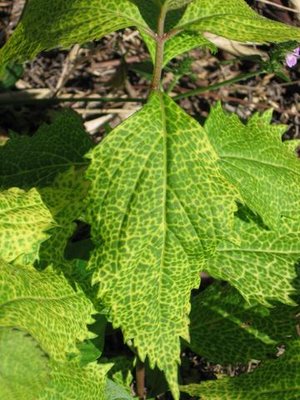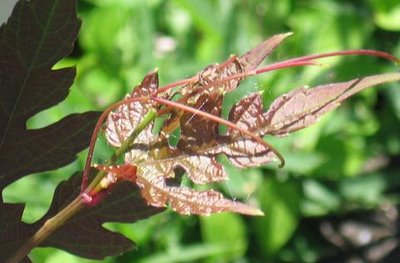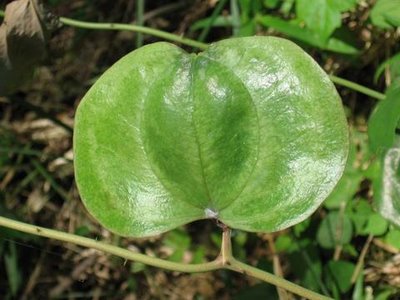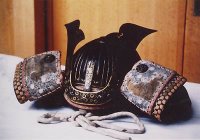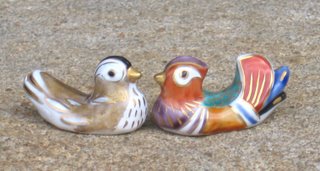9/27/2006
Pulse of my Heart
autumn meditation -
the pulse of my heart
in the injured ear
it is so quiet outside that I can hear the shhh shhh of my heartbeat inside the ear like a constand flowing stream ...
instead of counting the breath, this was my count today
:::::::::::::::::::::::::::::::::::::::::::::::::::::::::::::::::::::::::::::::::::::::::::::::::::::
Read my Haiku Archives from September 2006
***************************
Please send me your contributions
To the Daruma Museum Index
To the World Kigo Database
My Balance
finding my balance -
one sock on
each side

:::::::::::::::::::::::::::::::::::::::::::::::::::::::::::::::::::::::::::::::::::::::::::::::::::::
My daily life as inspriation for haiku, indeed ! :o)
Read my Haiku Archives from September 2006
***************************
Please send me your contributions
To the Daruma Museum Index
To the World Kigo Database
9/26/2006
Shadow of a Hawk
bright autumn sky -
the shadow of a hawk
in my hands
He was circling with his wife over my roof and garden, leisurely for more than half an hour. I could play with his slowly moving shadow ...
:::::::::::::::::::::::::::::::::::::::::::::::::::::::::::::::::::::::::::::::::::::::::::::::::::::
That's lovely GABI
Here's my response. . .
winter sun –
its slow rise above
the hawk's grand swoop
Kala
The hokku from Triparshva Renku: The Hawk's Grand Swoop
First appeared in Simply Haiku - Summer 06
... ... ...
Linking the two of your hawks, Kala and Gabi's, incidentally, a sparrow hawk, not very adult, has taken shelter in our garden, it's not very common here. So my Haiku as below-
Tearing the living
flesh of lizard, Sparrow Hawk
sheltering in garden.
Warmly,
Aju M, WHCindia
:::::::::::::::::::::::::::::::::::::::::::::::::::::::::::::::::::::::::::::::::::::::::::::::::::::
Hawk, a kigo for winter
Winter Birds
but today, it was my favorite .. ten takashi .. , the bright autumn sky
Autumn Sky
Aaa, and we had an earthquake this morning, one of the rare ones in Okayama prefecture.
!!! Earthquake !!!
. My Hawk in December 2011 .
Read my Haiku Archives
:::::::::::::::::::::::::::::::::::::::::::::::::::::::::::::::::::::::::::::::::::::::::::::::::::::
[ . BACK to WORLDKIGO . TOP . ]
[ . BACK to DARUMA MUSEUM TOP . ]
:::::::::::::::::::::::::::::::::::::::::::::::::::::::::::::::::::::::::::::::::::::::::::::::::::::
Harvest Meal
harvest time -
the meager meal of
a diabetic
Well, its salad and wakame seaweed soup for dinner again today !
And we are happy to be healthy with it ...
:::::::::::::::::::::::::::::::::::::::::::::::::::::::::::::::::::::::::::::::::::::::::::::::::::::
seaweed soup --
the sand in my shoe sieves
through my socks
--Billie
:::::::::::::::::::::::::::::::::::::::::::::::::::::::::::::::::::::::::::::::::::::::::::::::::::::
. Harvest and its Kigo .
Read my Haiku Archives from September 2006
***************************
Please send me your contributions
To the Daruma Museum Index
To the World Kigo Database
9/24/2006
Mirror Moon Mind
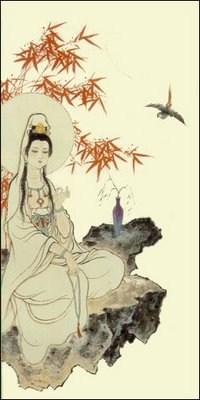
mirror moon mind -
on a rock in a lotus pond
by a bamboo grove
:::::::::::::::::::::::::::::::::::::::::::::::::::::::::::::::::::::::::::::::::::::::::::::::::::::
All the symbols of a classical haiku in one painting, one set of Buddhist iconography: The Water Moon Kannon.
One of my earlier haiku read:
quiet spring day -
the lake a mirror
but aaaa, the clouds !
With a Discussion on the Mirror Mind.
:::::::::::::::::::::::::::::::::::::::::::::::::::::::::::::::::::::::::::::::::::::::::::::::::::::
der Mond im Spiegel
der Spiegel im Mond
und wo bin ich ?
Immer eingeschaltet
Immer abgeschaltet
das ist mein Augenblick
Antei-Doo
:::::::::::::::::::::::::::::::::::::::::::::::::::::::::::::::::::::::::::::::::::::::::::::::::::::
Look at more images of Kannon Bosatsu, the Bodhisattva of Mercy
The above picture is quoted from here.
BuddhistDoor.com
Kannon Bosatsu
By Mark Schumacher
Ritual use of Mirrors in Buddhist Ceremonies
A mysterious revelation by Gabi Greve
QUOTE : Taoism, the concept of Ziran
QUOTE : Taoism is the mirror of life
QUOTE : God is the Mirror of Silence
QUOTE : correcting mistakes / Wan Yang-Ming
Kuhi, Haiku Monuments
... ... ... ... ...
Read my Haiku Archives from September 2006
:::::::::::::::::::::::::::::::::::::::::::::::::::::::::::::::::::::::::::::::::::::::::::::::::::::
[ . BACK to DARUMA MUSEUM TOP . ]
[ . BACK to WORLDKIGO . TOP . ]
:::::::::::::::::::::::::::::::::::::::::::::::::::::::::::::::::::::::::::::::::::::::::::::::::::::
9/23/2006
Leaves in Autumn
:::::::::::::::::::::::::::::::::::::::::::::::::::::::::::::::::::::::::::::::::::::::::::::::::::::
Autumn leaves, red leaves (momiji): KIGO
. World Kigo Database .
Read my Haiku Archives from September 2006
***************************
Please send me your contributions
To the Daruma Museum Index
To the World Kigo Database
Wonderful Weeds
 名も知らぬ 道端の友 雑草かな  wonderful weeds - not knowing your name do I know less ?  |
:::::::::::::::::::::::::::::::::::::::::::::::::::::::::::::::::::::::::::::::::::::::::::::::::::::
More of my WEED HAIKU
weeds are a non-seasonal topic for haiku
pulling my weeds -
what kind of a weed
is man ?
one single rose
between my weeds -
dream of enlightenment
typhoon tokage -
even the weeds
are fallen
pulling out weeds
one by one
old boyfriends remembered
problems -
weeds growing
in the summer sun
weeding
the never ending growth
of life
........................ With Photos to look at
Colors of Spring
Autumn Insects
After the storm ...
Star of Autumn
Frost on the Weeds
graves among weeds / Graeber zwischen Unkraut
Cat lurking behind weeds
Summer Sunrise
Pulling out weeds
:::::::::::::::::::::::::::::::::::::::::::::::::::::::::::::::::::::::::::::::::::::::::::::::::::::
妻なしが草を咲かせて夕涼
tsuma nashi ga kusa o sakasete yuusuzumi
a wifeless man
makes his plants bloom...
evening cool
This ku was written in 1815.
The year before Issa had married with Kiku, Chrysanthemum,
after his long single life in Edo city.
Tr. David Lanoue
this man without wife
brings (only) the weeds to bloom -
evening cool
Tr. Gabi Greve
I have a garden in Japan similar to Issa's and if I do not take proper care, only sturdy weeds will grow, no flowers, no vegetables.
Still I enjoy the evening cool looking over my small weed-flowers so full of strenght and power in the hot Japanese summer.
My motto has become :
May all my weeds be wild flowers.
I guess Issa is poking fun at himself.
:::::::::::::::::::::::::::::::::::::::::::::::::::::::::::::::::::::::::::::::::::::::::::::::::::::
taberu mono wa atte you mono mo atte zassoo no ame
I've something to eat
And something to make me drunk;
Rain in the weeds.
Santoka and Ricewine
xxxxxxxxxxxxxxxxxxxxxxxxxxxxx
tsumi susumu kusa yori cho no agari keri
as I weed
and move forward, a butterfly
has flown up
Nao Kataoka (1885-1953)
xxxxxxxxxxxxxxxxxxxxxxxxxxxxx
misty dawn ~
crazy old botanist seeking
new breeds of weeds
Narayanan Raghunathan
:::::::::::::::::::::::::::::::::::::::::::::::::::::::::::::::::::::::::::::::::::::::::::::::::::::
古葎祭の風のとどく也
furu mugura matsuri no kaze no todoku nari
old weeds--
the festival's breeze
reaches them
Kobayashi Issa
Alastair points out that in "Zen tradition, 'weeds' and 'brambles' are often used metaphorically for delusion/ignorance, and so one might read this verse as the spiritual rightness, or insightful wisdom (from or 'as' the festival) in its beneficence penetrating one's troublesome (lowly, common) old ways ... and doing so gently as a breeze..."
R. H. Blyth translates the mugura in this haiku as "goose grass," which he describes as a "symbol of desolation" that contrasts with the noisy, lively festival; A History of Haiku (Tokyo: Hokuseido, 1964) 1.361. Following Maruyama Kazuhiko, I have decided to render mugura, "weeds"; Issa haiku shuu (Tokyo: Iwanami Shoten, 1990; rpt. 1993) 288, note 1537.
Tr. and Comment : David Lanoue
mugura small creepeing weeds in marshlands
also ウグラ ugura、モグラ mogura
fam. Rubioidea
yae mugura ヤエムグラ
Kriechpflanze
goose grass amerika yaemugura アメリカヤエムグラ(cleavers)
a different plant with a similar name
kana mugura かなむぐら; カナムグラ/ 金葎/葎草
Humulus japonicus
japanischer Hopfen
. . . CLICK here for Photos !
. WKD : Cleavers 葎 mugura .
..... mogura もぐら
kana mugura 金葎(かなむぐら) 鉄葎 Humulus japonicus
yae mugura 八重葎(やえむぐら)Galium spurium
- - - - - and MORE
:::::::::::::::::::::::::::::::::::::::::::::::::::::::::::::::::::::::::::::::::::::::::::::::::::::
貧乏草愛たき春に逢にけり
binboogusa medetaki haru ni ai ni keri
little wild daisies -
even for you now
there is spring
Kobayashi Issa

binboogusa, Erigeron philadelphicus,
a kind of small white chrysanthemum, also called
harejion ハルジオン .
Literally it means "weed of the poor".
Skevish, Philadelphia Daisy
:::::::::::::::::::::::::::::::::::::::::::::::::::::::::::::::::::::::::::::::::::::::::::::::::::::
kigo for all winter
fuyugusa 冬草 (ふゆくさ)
weeds in winter, plants in winter
..... fuyu no kusa 冬の草(ふゆのくさ)
fuyuaogusa, fuyu aogusa 冬青草(ふゆあおくさ)green plants in winter
kansoo 寒草(かんそう) weeds and plants in the cold
:::::::::::::::::::::::::::::::::::::::::::::::::::::::::::::::::::::::::::::::::::::::::::::::::::::
KENYA
kigo for the dry seasons
. Weeds in Kenya
:::::::::::::::::::::::::::::::::::::::::::::::::::::::::::::::::::::::::::::::::::::::::::::::::::::
To the Daruma Museum Index
To the World Kigo Database
:::::::::::::::::::::::::::::::::::::::::::::::::::::::::::::::::::::::::::::::::::::::::::::::::::::
Nogiku wild chrysanthemum
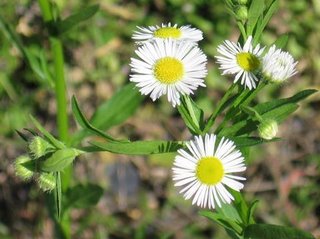 婦人会 皆花の咲く 野菊かな 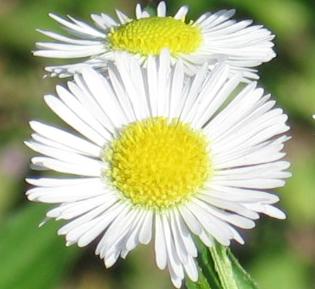 all so active in the Village Ladies Club - wild chrysanthemum  im Club der Weiber ist immer was los - wilde Chrysanthemen |
In my village is a Ladies Club called like this.
:::::::::::::::::::::::::::::::::::::::::::::::::::::::::::::::::::::::::::::::::::::::::::::::::::::
Wild Chrysanthemum, nogiku 野菊
kigo for late autumn
wild chrysanthemum by the roadside, nojigiku 野路菊
violet chrysanthemum, kongiku 紺菊
Many of them are names asters in English.
There are many varieties of the wild chrysanthemums. They flower abundantly in large groups in the wild on all the islands of Japan. The flowers are small and come in various colors. They are a big part of the "homeland" furusato feeling of the Japanese and have appeared in poetry since old times. They also refer to ladies of a rather reluctant character.
Our village ladies call themselves "Wild Chrysanthemum Group", nogiku no kai, but they are even active in local politics and dare speak up to the almighty mayor of our village, if need be !
:::::::::::::::::::::::::::::::::::::::::::::::::::::::::::::::::::::::::::::::::::::::::::::::::::::
野菊摘み来世は父母に甘えたき
nogiku tsumi raise wa fubo ni amaetaki
I pick wild chrysanthemums -
in the next world I want to be spoiled
by my parents
Shoobu Aya 菖蒲あや
:::::::::::::::::::::::::::::::::::::::::::::::::::::::::::::::::::::::::::::::::::::::::::::::::::::
wild chrysanthemums ~
the breeze flows on them
a gentle rhythm
Narayanan Raghunathan
:::::::::::::::::::::::::::::::::::::::::::::::::::::::::::::::::::::::::::::::::::::::::::::::::::::
kigo for mid-autumn
arechi nogiku 荒地野菊 (あれちのぎく)
wild chrysanthemum in a wasteland
arechi no kiku 荒地の菊(あれちのきく)
arechi nokiku 野塘菊(あれちのぎく)
inujioogiku いぬじおうぎく
asagirisoo 朝霧草 (あさぎりそう) "morning mist plant"
..... Hakusan yomogi 白山蓬(はくさんよもぎ)
yomogi mugwort from Hakusan mountain
. . . CLICK here for Photos !
Artemisia schmidtiana
isogiku 磯菊 (いそぎく) "chrysanthemum on the beach"
iwagiku いわぎく chrysanthemum on a rock
imokatsugi しもかつぎ
kirakusa きらくさ
hamagiku 浜菊 (はまぎく)
Ajania pacifica, Chrysanthemum pacificum, Chrysanthemum nipponicum
Kibunegiku 貴船菊 (きぶねぎく) wild aster from Kibune
shuumeigiku 秋明菊(しゅうめいぎく) "bright autumn chrysanthemum"
Anemone japonica
It grows wild in the mountains of Kibune, Kyoto.
. yomena no hana 嫁菜の花 (よめなのはな)
starwort flowers
:::::::::::::::::::::::::::::::::::::::::::::::::::::::::::::::::::::::::::::::::::::::::::::::::::::
kigo for early autumn
tetsudoogusa, tetsudoo gusa 鉄道草 (てつどうぐさ)
"railway plant"
a kind of wild chrysanthemum
Meijisoo 明治草(めいじそう)"Meiji-plant"
goisshingusa, go isshin gusa 御一新草(ごいっしんぐさ)
other name for ヒメムカシヨモギ
Erigeron canadensis, Conyza canadensis Erigeron
. . . CLICK here for Photos !
.................................................................................
oguruma 施覆花 (おぐるま) Inula britannica
..... oguruma 小車(おぐるま)"small wheel"
..... senpukuka せんぷくか
used in Chinese medicine. Xuanfuhua
. . . CLICK here for Photos !
.................................................................................
tamurasoo 田村草 (たむらそう) Seratula coronata
..... tamabooki 玉箒(たまぼうき)
..... yamabooki 山箒(やまぼうき)
Seratula coronata
a wild aster that looks almost like a thistle.
. . . CLICK here for Photos !
:::::::::::::::::::::::::::::::::::::::::::::::::::::::::::::::::::::::::::::::::::::::::::::::::::::
. Asters (fam. Diplopappus) Europe. China Aster (Callistephus)
Chrysanthemum (kiku 菊, a KIGO
. shion 紫苑 (しおん) Michaelmas daisy
Aster tataricus
Homeland, Hometown (furusato) Japan Heimat, Fatherland, Motherland
:::::::::::::::::::::::::::::::::::::::::::::::::::::::::::::::::::::::::::::::::::::::::::::::::::::
AUTUMN PLANTS -
SAIJIKI
[ . BACK to WORLDKIGO TOP . ]
[ . BACK to DARUMA MUSEUM TOP . ]
:::::::::::::::::::::::::::::::::::::::::::::::::::::::::::::::::::::::::::::::::::::::::::::::::::::
Higan with the Family
autumn equinox -
the dead old relatives
visit my dream
I woke up to the piano tunes of an old uncle, long gone, and my large German family home full of visitors .... what a get-together ...
:::::::::::::::::::::::::::::::::::::::::::::::::::::::::::::::::::::::::::::::::::::::::::::::::::::
Autumn Equinox, higan, 彼岸, a KIGO
Visit of a soul during O-Bon in Japan
. World Kigo Database .
***************************
Please send me your contributions
To the Daruma Museum Index
To the World Kigo Database
Higan Walk
 higan walk - the smell of incense from many graves  秋彼岸 香の漂う 墓となり  |
. Autumn Equinox (aki higan), a KIGO
Photo Album from my Autumn Walk
. World Kigo Database .
***************************
Please send me your contributions
To the Daruma Museum Index
To the World Kigo Database
9/22/2006
Dragonfly Tonbo
 dragonfly resting - another moment to share with you 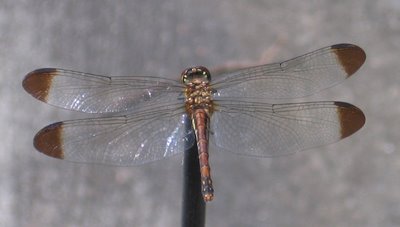 |
:::::::::::::::::::::::::::::::::::::::::::::::::::::::::::::::::::::::::::::::::::::::::::::::::::::
dragonfly -
patterns of life
patterns of death
Look at them here.
Gabi Greve, Happy Haiku Gallery
. Dragonfly, a KIGO : World Kigo Database .
. World Kigo Database .
***************************
Please send me your contributions
To the Daruma Museum Index
To the World Kigo Database
Zinnia (hyakunichisoo)
 in my garden for a hundred days ... the Zinnia 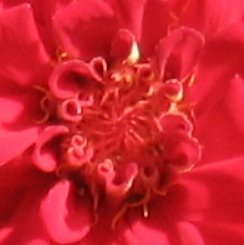 |
Zinnia, hyakunichisoo (one hundred days flower)
Zinnia elegans 百日草 (ひゃくにちそう. ヒャクニチソウ)
kigo for late summer
Zinn was a German biologist in the 18th century, who lend the name to the flower.
The origin is in Mexico. Around 1860, the flower was introduced to Japan. It comes in many colors.
. World Kigo Database .
***************************
Please send me your contributions
To the Daruma Museum Index
To the World Kigo Database
9/21/2006
Toad Lily ... hototogisu
 hototogisu - a spot of hope near the old graves 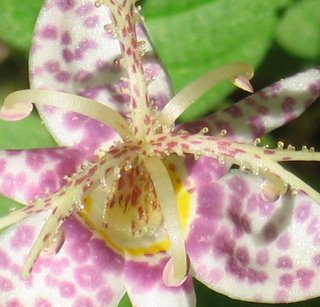 |
Toadlily, hototogisu 杜鵑草 (ほととぎす)
Japanese toadlily
..... yutensoo 油点草(ゆてんそう) (its Chinese name)
Tricyrtis hirta, Krötenlilie
kigo for early autumn
It grows wild in many mountain areas of Japan.
Since the pattern on the young leaves reminds the Japanese of the little cockoo (hototogisu bird ホトトギス , 子規 ), it got its name from it.
Birthday flower for September 12.
Cockoo, little cockoo (kankodori, hototogisu)
:::::::::::::::::::::::::::::::::::::::::::::::::::::::::::::::::::::::::::::::::::::::::::::::::::::
***** AUTUMN . . . PLANTS -
SAIJIKI
[ . BACK to WORLDKIGO . TOP . ]
:::::::::::::::::::::::::::::::::::::::::::::::::::::::::::::::::::::::::::::::::::::::::::::::::::::
Sage .. Salbei
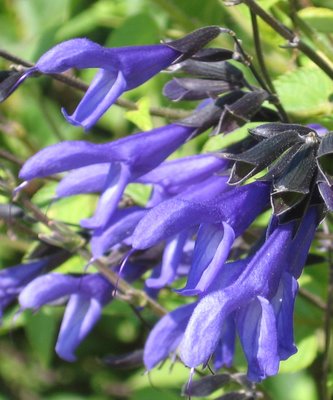 sage flowers - little things with a great power  |
Sage flowers, Salbei, seeji セージ、Salvia microphylla
Salvia, Scarlet sage, Salvia splendens, サルビア sarubia
kigo for late summer
some saijiki place it as a kigo for all autumn.
The flowers are seen rather long, from July till November.
It is the birthday flower for people born on August 31 and October 4.
salvea, in Latin language, means "health, healing". It was a powerful herb in olden times.
..........................................
Sage, the herb, in Ireland (and quite probably in the UK too) would be a Christmas kigo.
The traditional Christmas turkey is stuffed with a bread stuffing amply seasoned with onion and sage. In our town on Christmas Eve, both batch bread and dried sage powder completely sell out, and we have sometimes had to tour several shops before my sister could find both of them. The lesson of the story is, of course "Shop Early for Christmas"...!
To quote : "The flavour may be described as warm, pungent, slightly bitter with a hint of camphor... The combination of sage and onion for stuffing poultry is very well known. Sage is frequently used with rich and fatty dishes such as roast pork and eel, and is especially recommended with duck."
The Complete Book of Herbs and Spices, Claire
Loewenfeld and Philippa Back, 1978.
sage, she said --
there's an old jar of sage
behind these books!
Isabelle Prondzynski
:::::::::::::::::::::::::::::::::::::::::::::::::::::::::::::::::::::::::::::::::::::::::::::::::::::
Mugwort, yomogi 蓬 (よもぎ)
Artemisia princeps
kigo for all spring
Not to be mixed up with sage, it is a completely different plant.
:::::::::::::::::::::::::::::::::::::::::::::::::::::::::::::::::::::::::::::::::::::::::::::::::::::
. PLANTS - - - the Complete SAIJIKI .
[ . BACK to DARUMA MUSEUM TOP . ]
[ . BACK to WORLDKIGO . TOP . ]
:::::::::::::::::::::::::::::::::::::::::::::::::::::::::::::::::::::::::::::::::::::::::::::::::::::
Dancing with Butterflies
dancing with butterflies -
a sunny september afternoon
comes to an end

:::::::::::::::::::::::::::::::::::::::::::::::::::::::::::::::::::::::::::::::::::::::::::::::::::::
. World Kigo Database .
***************************
Please send me your contributions
To the Daruma Museum Index
To the World Kigo Database
Autumn Insects
aki no mushi . . . 秋の虫
autumn insects -
and the noise of my neighbour
cutting weeds
:::::::::::::::::::::::::::::::::::::::::::::::::::::::::::::::::::::::::::::::::::::::::::::::::::::
He uses a large weed cutter with a little motor, as we all do around here, going ziii ziii ziiiii, vibrating in the valley even louder than all our insects and the crows included ...
So much for a quiet autumn evening with the crickets ...
Insects (mushi) Autumn insects, aki no mushi,
. World Kigo Database .
***************************
Please send me your contributions
To the Daruma Museum Index
To the World Kigo Database
9/20/2006
Butterfly and white flowers
 autumn butterfly - the camera too slow for your actions  ooo ooo ooo ooo ooo ooo ooo ooo ooo  so much life on the small white flowers - autumn comes before the fall |
Butterfly, a kigo
Read my Haiku Archives from September 2006
. World Kigo Database .
***************************
Please send me your contributions
To the Daruma Museum Index
To the World Kigo Database
Karl the Frog
 observing Karl - his tiny thoat vibrates just SOOOO fast !  |
He lives in the clefts of the table panels and usually joins us during lunch and dinner time !
..........................................
Dear Gabi,
Thank you for the greetings from Karl.
I've attached a card for Karl to this letter.
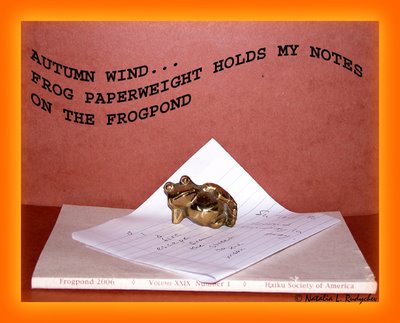
Sincerely,
Natalia L. Rudychev
http://haikushoot.blogspot.com/
Thanks so much, Natalia, for this card. I will treasure it!
Your tiny friend KARL
..........................................
Karl the Froggie
A Companion in my Garden
. World Kigo Database .
***************************
Please send me your contributions
To the Daruma Museum Index
To the World Kigo Database
Higanbana
 spider lilies - the face of a flower before it was born  |
Click here for another fun version of this theme !!!!
KOAN
What is your original face
before your parents were born?
Higanbana : Spider Lilies, cluster amaryllis
. World Kigo Database .
***************************
Please send me your contributions
To the Daruma Museum Index
To the World Kigo Database
Harvesting rice
| harvesting rice - the farmer's backs bent deeply  autumn in our terraced rice fields |
. Read my Haiku Archives of September 2006 .
. World Kigo Database .
***************************
Please send me your contributions
To the Daruma Museum Index
To the World Kigo Database
9/17/2006
Typhoon break
typhoon break -
the long whipping tail
of an unknown bird
:::::::::::::::::::::::::::::::::::::::::::::::::::::::::::::::::::::::::::::::::::::::::::::::::::::
after number thirteen -
the tiny frog back
on his watch
:::::::::::::::::::::::::::::::::::::::::::::::::::::::::::::::::::::::::::::::::::::::::::::::::::::
We have been waiting for this typhoon Nr. 13 for a few days now, it moved soooo slow, hovering about Kyushu, but finally, it is here close to our area and will help us spend a sleepless night ...
Sitting on my veranda, I try to enjoy the racing clouds and some crows venturing in the orchard of my neighbour for dinner
... and then this little fellow on the old dry tree branch sticking out in the sky ... the highest place during a rain-less moment ...
Wish me good luck until tomorrow !
Typhoon Nr. 13 SHANSHAN(サンサン)
And as you can see from the haiku above, next morning, our frog KARL was back ... not too much damage and Number 14 well on its way !
. World Kigo Database .
***************************
Please send me your contributions
To the Daruma Museum Index
To the World Kigo Database
9/16/2006
Teapot philosophy
Daruma on Tea Pots <> 急須にだるま
Gabi Greve
Japanese Tea Ceremony Saijiki <> 茶道の歳時記
. World Kigo Database .
***************************
Please send me your contributions
To the Daruma Museum Index
To the World Kigo Database
Change in Life
| forever changing the clouds and I |
Read this essay :
The Challenge of Change
by Mick Quinn
Clouds in my Haiku Valley
Gabi Greve
. World Kigo Database .
***************************
Please send me your contributions
To the Daruma Museum Index
To the World Kigo Database
9/15/2006
Tao of a useless tree
useless tree -
too old to move,
I just sit here
:::::::::::::::::::::::::::::::::::::::::::::::::::::::::::::::::::::::::::::::::::::::::::::::::::::
A TREE story from Chuang Tzu
A certain carpenter was traveling with his helper. They came to a town where a giant oak tree filled the square. It was huge, with many limbs spreading out; large enough to shade a hundred oxen and its shade covered the entire square. The helper was amazed at the potential lumber contained in this one tree but the carpenter passed it by with a mere glance. When his helper asked him why he had passed up such a magnificent specimen the carpenter replied that he could see at once that the great oak's branches were useless to him.
"They are so hard," he said, "that were I to take my ax to them it would split. The wood is so heavy that a boat made of it would sink. The branches themselves are so gnarled and twisted they cannot be made into plants. If I tried to fashion house beams with it they would collapse. If I made a coffin from it you would not be able to fit someone inside.
Altogether it is a completely useless tree.
And that is the secret of its long life."
Chuang Tzu
in Tales from the Tao: Inspirational Teachings from the Great Taoist Masters
by Solala Towler
Practicing Spirituality with Taoists
http://www.spiritualityandpractice.com/
ooo ooo ooo ooo ooo ooo ooo ooo ooo
From my Haiku Archives
Trees, my best friends .. 巨木
Camphor Tree Kusunoki 楠木 くすのき
. World Kigo Database .
***************************
Please send me your contributions
To the Daruma Museum Index
To the World Kigo Database
9/11/2006
sound of sleet
音は時雨 か
oto wa shigure ka
Santoka Santooka 山頭火
the sound, oh,
it's sleet !
WKD Rain in various Kigo
.........................
Comment from Larry Bole:
Here is what Burton Watson says in the introduction to his book of translations of Santoka's haiku, "For All My Walking:"
"Modern Japanese in nearly all cases requires more syllables or sound symbols to express a given idea or image than does modern English and so English translations of Japanese haiku, if not deliberately padded, will almost inevitably turn out to be briefer in wording than the originals. And when confronted with a poem such as Santoka's haiku 'oto wa shigure ka,' one comes out with something looking like this:
that sound
the rain?
Can an utterance as brief as this be called a poem? I leave it to readers to decide."
--Larry
p.s. I'm not sure I agree with Watson, since he seems to be comparing the number of Japanese syllables or sound symbols in a Japanese haiku to the number of syllables in the English words in a translation of that haiku into English. I don't understand why he isn't comparing the number of Japanese words in a given Japanese haiku to the number of words in the English translation of that haiku.
Aren't there situations where you may have fewer Japanese words, in spite of the larger total number of syllables they contain, but need more English words to make the haiku read well in English, even if the English words combined contain fewer total syllables than does the Japanese original?
In the appendix in Henderson's "An Introduction to Haiku," he defines "ka" as: "A verbal question mark."And Higginson, in the glossary in "The Haiku Handbook," defines "ka"as:"--emphasis; at the end of a phrase, makes a question."
Translating Haiku
... ... ...
Gabi writes:
Normally, ka is of course the question mark in written and spoken Japanese, but from my long experience with the living language, I come to notice many uses where it feels a lot more like an exclamation mark.
in a typical question, it comes with a ... desu ka?
but in a spoken statement like this
ara .. ame ka
I feel it is a lot more like ... oh look it's raining!
as a statement, not a question like . ... Is this rain?
I saw a beautiful hiragana rendering of this prase, making it in three lines
oto wa
shi gu re
ka
with a very large KA compared to the smaller longish shi.. gu.. re line.
saaa, iku ka ..... means basically
let's go !
By the way, ... aaa, kyoo mo ame ka , ... was my first thought this morning, with the sound on the roof and it means simply
oh gosh, rain again today !
NEXT
to translate SHIGURE simply as RAIN, as Watson does, does not make much sense, since he then misses the kigo of this KU.
The sound of sleet for example on a Japanese temple roof is something you must have heared to believe its impression ...
I often go to our local shrine during sleet just to listen to this sound !
And I can easily imagine Santoka and Ryokan san sitting right next to me for this enjoyment!
... ... ...
Norman writes:
Hi Gabi, Larry and all
As you know my Japanese is too meagre to offer any worthwhile comment directly on the Japanese usage here, but having studied a rather broad range (in both space and time) of languages, I have been struck by how commmon is and has been for millennia the usage of a question-formula to make an emphatic statement, such as, "Isn't it a beautiful day, today [with optional ?]" which in usage is not a question at all, and hardly needs a response.
It occurs to me that Santoka's haiku in question may use a similar mechanism, though I freely own I may be completely wrong.
Norman
... ... ...
Larry writes:
Dear Gabi, Norman, and all,
Since my knowledge of Japanese is virtually non-existant, I defer to all experts, even when the experts have differing opinions.
Is it possible that certain words might have a literary usage that is different from their everyday usage?
Gabi, I agree with your example of seeing the phrase written out. The emphasis you describe regarding how "ka" is written certainly supports your contention.
And Norman, your point is certainly plausible. In English, what you describe is called a 'rhetorical question', which is when a question is used more as a statement than a question.
Here is a definition of 'rhetorical question' from Wikipedia:
"A rhetorical question is a figure of speech in the form of a question posed for rhetorical effect rather than for the purpose of getting an answer. ("How many times do I have to tell you to stop walking into the house with mud on your shoes?").
"A rhetorical question seeks to encourage reflection within the listener as to what the answer to the question (at least, the answer implied by the questioner) must be. When a speaker declaims, "How much longer must our people endure this injustice?" or "Will our company grow or shrink?", no formal answer is expected. Rather, it is
a device used by the speaker to assert or deny something."
--Larry
and one more from Larry:
Dear Gabi,
It's interesting to consider whether Santoka meant sleet.
In Watson's book of translations, he includes dated exerpts from Santoka's diaries, and haiku/poems written therein as well.
If Watson's chronology is accurate, he puts "oto wa shigure ka" at the end of a group of twelve haiku/poems he translates which appear between a diary entry dated August 9, 1932, and one dated September 19, 1932. In fact, the first haiku in this group is the recently discussed
utsurikite ohiganbana no hanazakan
(moving in / higan lilies / at their best).
Watson says in his introduction (in fact in the paragraph that precedes the one I quoted previously):
"My.. .interest in Santoka's work centers... on the poetry itself [contrasting this with John Stevens' book of translations, "Mountain Tasting: Zen Haiku by Santoka Taneda," which focuses on the Zen aspects of Santoka's haiku], particularly the manner in which it experiments with different poem lengths and syntactic patterns, and the challenge that these present to the translator.
Since free-style haiku do not adhere to the conventional 5-7-5 sound pattern, the translator is free to break them more or less wherever he or she wants or, like Hiroaki Sato in his translation of Ozaki Hosai's free-style haiku, to translate them as a single line of English [and, as a matter of fact, Sato has published a book of single-line translations of Santoka's haiku, "Santoka :: Grass and Tree Cairn"].
I have regularly broken my own translations into two or three lines in the hope that this division will help readers grasp the syntax of the poem and slow down the reading."
One thing I like about this brief Santoka haiku under discussion, is the rhyme between "wa" and "ka." I can't help but think that this is part of why Santoka evidently found this phrase so pleasing.
Higginson doesn't have anything to say about "wa"; while Henderson says:
"WA は
A particle which is usually followed by a noticable pause. It is much like an English 'as for' so-and-so, in that it not only marks what we are talking about, but also suggests a comparison with other things not mentioned."
I am guessing that Santoka wanted his readers to think about what the sound he heard might be. I know I have woken up during an early autumn night, when it's cool enough for a blanket but we still have the bedroom windows open, and thought I heard it raining, and thought that I would have to get up and close the windows, but then discovered the sound was only the wind rustling the early autumn leaves.
Given the time of year in which Santoka seems to have written this haiku (again, based on Watson's chronology), it is surprising to me that Santoka would use "shigure" rather than "akisame," "aki no ame," or even "akishigure." So maybe he did indeed mean "sleet."
Perhaps there was an unseasonably early sleet shower, for which he felt the best word was "shigure." Or perhaps he heard autumn rain, but decided he liked setting the experience in winter better!
Anyway, I like imagining you, Gabi, going to a temple just to hear the sound of sleet on the roof!
Larry
p.s. Speaking of Santoka translations, Blyth, sounding surprised at himself, devotes a whole chapter (Chapter XXXII) to Santoka in "A History of Haiku, Volume Two." Blyth begins the chapter this way:
"To give a modern poet a whole chapter to himself, albeit a short one, may seem strange..."
All the more strange, considering that Blyth has a generally low opinion of haiku written between Issa and Shiki, and an even lower opinion overall of post-Shiki haiku. However, he gives Santoka a chapter to himself because he is a 'modern' representative of "the small group of beggar-like haiku poets; Rotsuu is another example, and Basho and Issa are not dissimilar."
... ... ...
Thanks to all for their contributions !
More on the Winter drizzle, sleet, shigure
GABI
:::::::::::::::::::::::::::::::::::::::::::::::::::::::::::::::::::::::::::::::::::::::::::::::::::::
. World Kigo Database .
***************************
Please send me your contributions
To the Daruma Museum Index
To the World Kigo Database
9/10/2006
Tea Ceremony
tea ceremony -
the sound of wind blown pines
in a painting
adapted from
Sen Sotan
Third-Generation Grand Tea Master (1578-1658)
sen sootan
:::::::::::::::::::::::::::::::::::::::::::::::::::::::::::::::::::::::::::::::::::::::::::::::::::::
COOLNESS, and the stageing of it in the tea ceremony
More of the Wisdom of Sen Soshitsu
(Sen Sooshitsu 裏千家の家元、千宗室)
Coolness and Tea in Summer
. World Kigo Database .
***************************
Please send me your contributions
To the Daruma Museum Index
To the World Kigo Database
9/09/2006
Cows in India
holy shit !
the cow does it
in plain sunshine
:::::::::::::::::::::::::::::::::::::::::::::::::::::::::::::::::::::::::::::::::::::::::::::::::::::
Look at my PHOTO ALBUM from BENARES
the ardent pilgrim -
herding his cows like
herding his thoughts
Read it all here
The Pilgrim Herder
:::::::::::::::::::::::::::::::::::::::::::::::::::::::::::::::::::::::::::::::::::::::::::::::::::::
. WKD : Pissing (shooben 小便) .
[ . BACK to WORLDKIGO . TOP . ]
[ . BACK to DARUMA MUSEUM TOP . ]
:::::::::::::::::::::::::::::::::::::::::::::::::::::::::::::::::::::::::::::::::::::::::::::::::::::
9/08/2006
Organic World News
:::::::::::::::::::::::::::::::::::::::::::::::::::::::::::::::::::::::::::::::::::::::::::::::::::::
GENETICALLY ENGINEERED
"FRANKENGRASS"
SPREADS INTO THE WILD
________________________________
An experimental variety of genetically engineered bentgrass has escaped from its test plot in Oregon and has been found growing in the wild as far as three miles away, according to scientists from the U.S. Environmental Protection Agency. The biotech plant, designed for golf courses, has not been approved by the US Department of Agriculture, but has already been found dispersing among native grasses in six different locations.
Scientists say they don't know how it will behave in the wild but admit it may have a strong advantage over native grasses, and could therefore irreversibly damage the ecosystem as it spreads.
www.organicconsumers.org
frankengrass <>
Frankenstein laughs
in his grave
Humans are taking good care of the world ! Are they ?
ooo ooo ooo ooo ooo ooo ooo ooo ooo
.............................. Later about "Franken rice"
U.S. Rice Supply Contaminated
LLRICE 601 on the loose
frankenfood
on the rise
franken rice
Read the details HERE !!!!!
:::::::::::::::::::::::::::::::::::::::::::::::::::::::::::::::::::::::::::::::::::::::::::::::::::::
INDIA ORGANIC EXHIBITION IN BANGALORE
----------------------------------------------------------
The International Competence Centre for Organic Agriculture (ICCOA) is organizing "India Organic", the Indian exhibition for organic products in Bangalore, India, for the second time from 9-12 November 2006. The exhibition is intended for trade exhibitors and visitors. India Organic got off to a convincing start at its première in November 2005, when 180 exhibitors from all over India and the world attracted 30,000 visitors to the exhibition halls. A 3-day congress programme was attended by 500 visitors. India Organic 2006 will beat these figures.
India with slightly more than a billion people is one of the world's fastest growing economies and one of the three leading producers of milk, fruit and vegetables, poultry, rice, wheat, tea, herbs and spices. The middle class of about 150 million people is becoming increasingly interested in
environmental and food matters.
http://www.indiaorganic2006.com/
organic India <>
how many hungry
can it feed ?
:::::::::::::::::::::::::::::::::::::::::::::::::::::::::::::::::::::::::::::::::::::::::::::::::::::
. Golf Haiku and Senryu .
[ . BACK to DARUMA MUSEUM TOP . ]
[ . BACK to WORLDKIGO . TOP . ]
:::::::::::::::::::::::::::::::::::::::::::::::::::::::::::::::::::::::::::::::::::::::::::::::::::::
9/06/2006
Chandrika Soap
Chandrika soap -
the smell of India
in my Japanese bath

Chandrika soap -
a whiff of Ayurveda
on his German skin
:::::::::::::::::::::::::::::::::::::::::::::::::::::::::::::::::::::::::::::::::::::::::::::::::::::
A friend has sent us a few cakes, and it brings back great memories of the outdoor shower room in Goa, where the monsoon would sometimes provide some additional shower power ...
India's natural, herbal, ayurvedic bath soap for freshness, cleanliness and health in a holistic-ayurvedic way.
www chandrika soap
:::::::::::::::::::::::::::::::::::::::::::::::::::::::::::::::::::::::::::::::::::::::::::::::::::::
A friend from India wrote :
Dear Gabi san
"chandrika" means "the moon faced one" or "luminous like the moon" ~ It is a female name.
I had a childhood friend called Chandrika.
chandra ~ moon ! [ Both Sanskrit words used in most Indian Languages
except the Urdu derived ones. ]
Incidentally this soap is made in Keralam where I live. We have been using it for over fifty years in our house! New versions of the same brand are available too now.
So you have an implicit polylingual autumn kigo!
NR
.................................................................................

Chandrika Soap is made with pure vegetable oils such as purified Coconut oil, Sandalwood oil, and Patchouli oil.
The soap does not use any animal fat or products.
Chandrika Soap is not tested on animals.
The product was launched in 1940. Even though the concept and founded by C. R. Kesavan Vaidyar, it is now owned by Bangalore headquartered Wipro.
- Reference -
:::::::::::::::::::::::::::::::::::::::::::::::::::::::::::::::::::::::::::::::::::::::::::::::::::::
. World Kigo Database .
Chandrika Soap
kigo for autumn in
. The INDIA Saijiki of the World Kigo Database .
[ . BACK to DARUMA MUSEUM TOP . ]
[ . BACK to WORLDKIGO . TOP . ]
:::::::::::::::::::::::::::::::::::::::::::::::::::::::::::::::::::::::::::::::::::::::::::::::::::::
Prayer of the Rain
| 雨の音 屋根が教える 南無阿弥陀 sound of rain - my roof teaches me the Amida Prayer ooo ooo ooo ooo ooo ooo ooo ooo ooo 雨の音 おどる達磨の 足音じゃ  sound of the rain - Daruma is dancing on my roof |
In a dream last night, the pounding sound of the rain on my large roof started transforming into "Namu Amida Butsu", the prayer to Amida, as if he was teachting me himself to be fearless in stormy weather.
Imagine each rain drop a little Daruma dancing on the roof !
Now I am ready to live through another day of great storm ...
The Story of Daruma Dancing だるま夜話
Amida Nyorai and the Amida Prayer:
Namu Amida Butsu 南無阿弥陀仏
My large roof ...
:::::::::::::::::::::::::::::::::::::::::::::::::::::::::::::::::::::::::::::::::::::::::::::::::::::
Dear Gabi,
If you ever publish a book of your haiku, please reserve a copy for me!
It seems I have come across haiku in which things like streams, and animals such as doves, have also chanted the nembutsu.
There is one in particular by Buson, but before that, read the explanation of the Ceremony:
"Juuya" 十夜法要 is a special ceremony for 10 days of the Amida sects of the Pure Land (Jodo), from October 5 to 10 of the old lunar calendar.
O-Juya means "ten nights.” In the Sutra of The Infinite Life, it says: “If good is practiced in the secular world for ten days and nights, it is superior to the practice of good in the Buddha’s land for one thousand years. The reason is that there are few who do bad in the Buddha’s Land. The blessings and virtues are natural and there is no creation of bad in Buddha’s land. Only this world has wickedness and the blessings and virtues are not natural.”
Because of this verse in the sutra, the O-Juya service confirms our commitment not to do any thing bad and to do every good.
あなたうと茶もだぶだぶと十夜哉
あなたふと茶もだぶだぶと十夜哉
anata futo cha mo dabu-dabu to juuya kana
Ah, the blessed sound!
The tea also says, "Da-bu, da-bu!"
The ten nights.
tr. Blyth
The season's holy chant
from the teapot too, "dabu, dabu"--
for ten nights.
tr. Sawa and Shiffert
And one I found by Ryoota:
shirayuki no naka ni koe ari kan nembutsu
Within the clouds
There are voices:
Winter nembutsu.
tr. Blyth
So you are in good company!
Larry
Thanks so much, Larry.
In this case here is another of our Amida experiences you might enjoy
and click HERE to look at this voice !
:::::::::::::::::::::::::::::::::::::::::::::::::::::::::::::::::::::::::::::::::::::::::::::::::::::
. World Kigo Database .
***************************
Please send me your contributions
To the Daruma Museum Index
To the World Kigo Database
9/03/2006
Sprinkling Water
打ち水や 蝶の飲み場となりにけり
uchimizu ya choo no nomiba to nari ni keri
sprinkling water -
all the pretty butterflies
come for a drink
:::::::::::::::::::::::::::::::::::::::::::::::::::::::::::::::::::::::::::::::::::::::::::::::::::::
Sitting on my veranda, looking at the stone floor sparkling in fresh water ...
It is so quiet, I can almost hear the little snouts slurping the freshness ...
Sprinkling Water, a KIGO for Summer
Butterfly, a KIGO for Spring
KIGO – Its use in haiku ... About the use of two or more kigo.
:::::::::::::::::::::::::::::::::::::::::::::::::::::::::::::::::::::::::::::::::::::::::::::::::::::
Gabi san
The haiku is one about an aspect of dampening the walkway in front of the home to keep the dust down and a prepatory purification (Shinto?) for arriving guests?
This is done as part of the formal tea ceremony too? Also, "butterfly" (chou) is summer kigo, so?
I like the emotions that your haiku evoke in me. I miss visiting Japan and of course, your wonderful place.
Would it be possible for me to use your haiku in my BLOG?
Greetings from Georgia, USA
ai... chibi
:::::::::::::::::::::::::::::::::::::::::::::::::::::::::::::::::::::::::::::::::::::::::::::::::::::
. World Kigo Database .
***************************
Please send me your contributions
To the Daruma Museum Index
To the World Kigo Database

